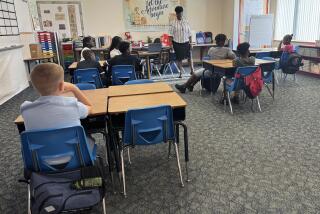Schools Restructure to Meet Challenges of Today’s Students
- Share via
Responding to new pressures on American schoolchildren, many schools are changing the way they are organized and how they teach.
The process is called restructuring, and if you haven’t heard much about it yet, you will, because school districts throughout the country are getting into the act.
What’s behind the trend is a growing awareness among teachers and administrators that large numbers of their students face serious obstacles to learning, and that the old ways of running schools are obsolete. In order to educate, schools must now address the needs of “the whole child.”
The obstacles to learning are many, but the most serious is that a distressing number of children come to school in no condition to learn: ill-fed, with a variety of emotional problems, and with little encouragement from home to avoid trouble and succeed.
Rising health care costs also mean that students are going untreated for problems that make learning more difficult, such as hearing or vision impairments.
Meanwhile, massive immigration is flooding some schools with students who speak little or no English.
Restructuring to respond to these problems includes several steps. Ideally, the school staff, parents, local businesses and other community members participate in every phase, since all have a stake in the school’s success.
The process differs from school to school and district to district, but here’s how it is unfolding at my school, Santa Monica High, where restructuring is in its second year.
Our first step has been “visioning.” In a succession of meetings stretching over the school year, faculty and staff have been trying to compose a very specific description of what a student should be like upon leaving the school. What academic foundation should we insist on? What social skills and values are vital? And so on.
Our next step will be to write a “mission statement,” listing specific goals that the school must reach in order to produce the ideal student.
Finally, an action plan will be developed, setting forth what will be done on a concrete, day-to-day basis to reach the goals and produce a capable student.
It takes a lot of discussion and teamwork from the school staff to accomplish this. Much of our restructuring work at Santa Monica High has occurred during the few days in the school year when students are excused.
Already, some changes have been implemented. Last year, for example, we introduced a Freshman Focus program, in which the ninth-grade class is divided into groups of about 120 students. All the students in a group have the same teachers for a core academic program of English, math and science.
It doesn’t sound like a radical change, but in fact it is significant. The English, math and science teachers confer regularly about the students they share. They are given extra time to meet with their students and contact parents. In a similar vein, we have altered the counseling process. Starting this year, each class is assigned to a specific counselor and a specific vice principal, who will follow the class through their entire four years of high school. Again, the goal is to develop a continuing, caring relationship between students and counselors.
So far, our changes are relatively modest. We have many choices ahead.
At some schools, restructuring has brought changes in the daily schedule, so that students spend more than the traditional 50 minutes in each class. When class periods are longer, teachers tend to lecture less and rely more on activities such as discussions, guest speakers, labs, student presentations, films and art projects.
Team-teaching, in which teachers from allied subjects mix their curricula, is also common in restructured schools. Ideally, team-teaching helps the student to see connections between otherwise isolated fields of knowledge.
Many restructured schools also develop close ties with nearby businesses who provide guest speakers, field trips and on-the-job-training.
To meet some of the non-academic needs of students, some schools are linking up with social service agencies to provide counseling for such things as drug and alcohol abuse, gang involvement, and suicide prevention. Health clinics are sometimes set up for children whose families can’t afford basic medical care. We are exploring this option in Santa Monica.
Finding money for the new services is obviously a challenge. Some changes, such as altering the daily schedule, cost little. Others, such as health clinics, are expensive.
Funding for some programs and materials is available from special restructuring grants from the state, or from corporate donations and sponsorships.
Redesigning a campus, schedule and new way of teaching is a tall order for schools, but many of them are seeing that it must be done.






